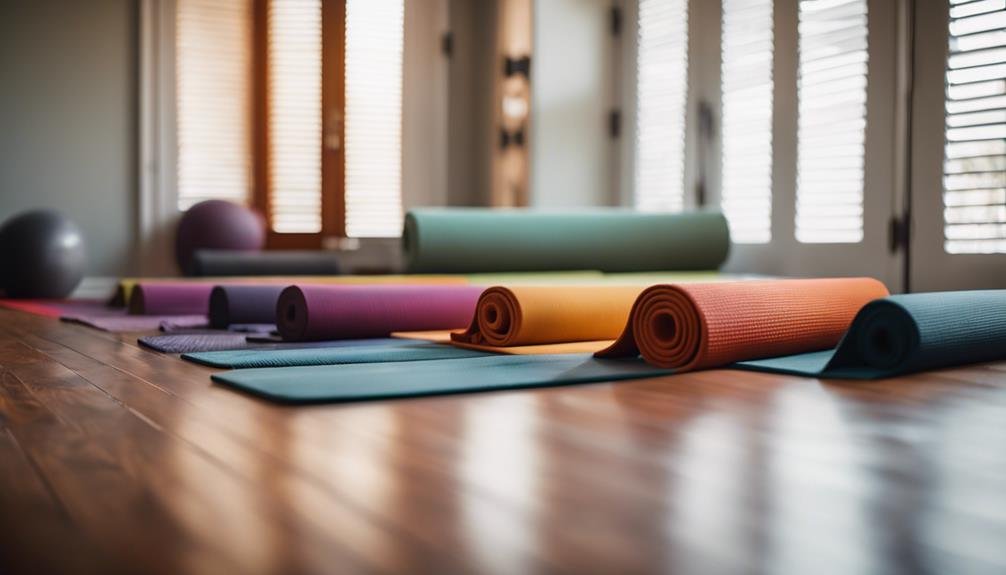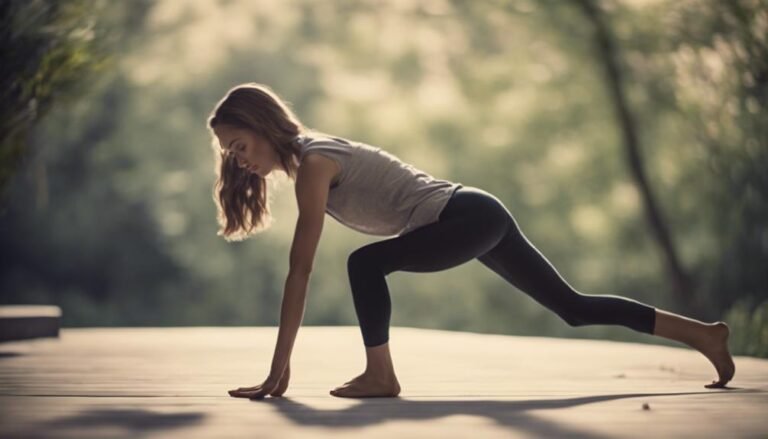Don't miss our holiday offer - 20% OFF!

Choosing the Perfect Yoga Mats for Your Home Practice
Get ready to elevate your yoga practice with the perfect mat, but first, discover the key features that will make all the difference.
As we begin our home yoga practice, we're investing in our well-being, and choosing the perfect yoga mat is the first step. We consider our unique needs and goals, reflecting on our yoga style, preferred thickness, and eco-friendly material options. Grip and traction are critical, and we prioritize joint support and cushioning. Premium mats offer advanced technology, while eco-friendly options reduce our environmental footprint. By weighing these factors, we'll find a mat that aligns with our practice. Now, let's dive deeper into the key features that'll take our practice to the next level.
Key Takeaways
- Consider your personal priorities and practice goals to ensure the perfect yoga mat aligns with your unique needs and preferences.
- Choose a material that suits your practice, such as eco-friendly options like natural rubber, bamboo, or recycled PVC, each with unique benefits.
- Select a thickness that provides the right balance of comfort, performance, and connection to the earth, with thicker mats offering extra cushioning and support.
- Look for a mat with a textured surface, ridges, or bumps to provide extra grip and traction, preventing slipping and falling during your practice.
- Reflect on your personal preferences for soft and cushy or firm and grippy, and consider extra cushioning for joints or a travel-friendly option.
Understanding Your Yoga Style
As we set out on the journey to find our perfect yoga mat, we first need to understand our unique yoga style, which will ultimately dictate the ideal mat features that cater to our individual needs. Our yoga style is deeply rooted in our personal preferences and yoga philosophy. Are we more into Hatha, Vinyasa, or Restorative yoga? Do we prioritize alignment, flexibility, or mindfulness? Understanding our yoga style helps us identify the specific features we need in a mat. For instance, if we're into hot yoga, we'll want a mat with excellent grip and sweat resistance. If we're more into Yin or Restorative yoga, we might prioritize comfort and cushioning. By recognizing our unique yoga style, we can narrow down our options and find a mat that complements our practice. By doing so, we'll be able to focus on our breath, movement, and inner awareness, rather than being distracted by discomfort or slipping.
Thickness Matters: What to Consider
We've narrowed down our yoga mat search by understanding our unique yoga style, and now we're faced with another essential decision: choosing the right mat thickness, which can profoundly impact our practice's comfort, performance, and overall experience.
When it comes to thickness, we need to take into account our personal preferences and needs. A thicker mat provides extra cushioning and support, which is ideal for practitioners who need more comfort and joint protection. On the other hand, a thinner mat is better suited for those who prefer a more grounded, connected feel to the earth.
Mat density also plays a vital role in determining the overall comfort and performance of our practice. A denser mat provides more support and stability, while a less dense mat offers more cushion flexibility. We should weigh our weight, yoga style, and personal comfort level when selecting the perfect mat density.
Ultimately, finding the perfect mat thickness is a personal decision that requires careful deliberation. By understanding our unique needs and preferences, we can choose a mat that enhances our practice, providing the comfort, support, and performance we need to take our yoga to the next level.
Material Selection: Eco-Friendly Options
Selecting a yoga mat that not only feels great under our hands and feet but also aligns with our values is essential, which is why we're turning our attention to eco-friendly material options. As yogis, we aim to cultivate a deeper connection with nature, and our yoga mat choice can have a significant impact on the environment.
When it comes to eco-friendly materials, we have several options to examine. Here's a breakdown of some popular choices:
| Material | Sustainable Sourcing | Benefits |
|---|---|---|
| Bamboo | Yes | Bamboo benefits include high durability, resistance to moisture, and natural antimicrobial properties. |
| Natural Rubber | Yes | Natural rubber is biodegradable, non-toxic, and provides excellent grip. |
| Recycled PVC | Yes | Recycled PVC reduces waste, conserves resources, and offers a soft, comfortable surface. |
| Jute | Yes | Jute is a highly renewable resource, biodegradable, and provides a natural, earthy feel. |
Grip and Traction: Key Features
We're now focusing on the grip and traction of our yoga mat, a critical aspect that can make or break our practice. A good grip is essential to prevent slipping and falling, especially when we're moving through complex sequences or holding challenging poses. We've all been there – trying to balance in tree pose on a slippery floor, or struggling to maintain downward-facing dog on a mat that's as slick as ice. It's frustrating, and it can be dangerous.
That's why we need a mat with a tacky surface that grips our hands and feet securely. Look for mats with textured surfaces, ridges, or bumps that provide extra traction. These features will help us maintain our balance and stability, even in the most challenging poses. And when we're practicing on slippery floors, a mat with excellent grip can be a lifesaver. By choosing a mat with superior grip and traction, we can focus on our practice, not on worrying about falling over.
Joint Support and Cushioning
Practicing yoga can be tough on our joints, and that's why a good yoga mat is essential for providing adequate cushioning and support to reduce the impact on our bodies. As we move through various poses, our joints take a beating, especially our knees and spine. A high-quality yoga mat can make all the difference in providing the necessary joint support and cushioning.
Key features to look for in a yoga mat that prioritizes joint support and cushioning:
- Knee Relief: Look for mats with extra cushioning in the knee area to reduce pressure and discomfort.
- Spinal Alignment: A good mat should provide adequate support for our spine, promoting proper alignment and reducing strain on our back.
- Thick and Dense Material: A thicker, denser mat provides better cushioning and support for our joints.
- Textured Surface: A textured surface can help reduce slipping and sliding, reducing the impact on our joints.
- Eco-Friendly Materials: Opt for eco-friendly materials that are gentle on our skin and the environment.
Size Matters: Mat Dimensions
As we focus on optimizing our yoga practice, we need a mat that fits our unique needs, and that starts with finding the perfect size. When it comes to mat dimensions, it's essential to consider our personal preferences and the type of yoga we practice. Typically, yoga mats range from 24" to 26" in width and 68" to 72" in length. However, some mats can be as short as 60" or as long as 80". We should choose a mat that allows us to move freely, without feeling cramped or restricted.
Mat thickness is also crucial, as it affects our joints and overall comfort. Thicker mats (4-5 mm) provide extra cushioning and support, making them ideal for beginners or those with joint issues. Thinner mats (3-4 mm), on the other hand, are better suited for more advanced yogis who prefer a closer connection to the ground. Additionally, we should consider mat weights, which can range from 2-5 pounds, depending on the material and size. A lighter mat is perfect for traveling, while a heavier one is better suited for home practice. By selecting the right size and thickness, we can ensure a comfortable and effective yoga practice.
Color Options: Aesthetics and More
Nearly every yoga mat on the market offers a diverse range of colors, from subtle earth tones to vibrant hues, allowing us to choose a shade that reflects our personal style and complements our practice environment. But color options go beyond aesthetics; they can also impact our mood and energy. This is where Color Psychology comes in – the study of how colors affect our emotions and behavior.
When selecting a yoga mat, we can consider the emotional responses we want to evoke during our practice. For example:
- Calming shades like blue and green can promote relaxation and balance.
- Energizing colors like orange and red can stimulate creativity and enthusiasm.
- Neutral tones like beige and gray can create a sense of calmness and serenity.
- Earthy shades like brown and terracotta can connect us with nature.
- Vibrant hues like pink and purple can inspire playfulness and creativity.
Brand Reputation and Quality
We look for brands that have built a reputation for producing high-quality yoga mats that meet our performance expectations and align with our values. A brand's reputation is essential in ensuring we get a mat that's reliable, durable, and safe for our practice. We prioritize manufacturers that prioritize transparency, openly sharing information about their materials, production processes, and environmental impact. This transparency is key in building trust and confidence in the brand.
Industry certifications, such as eco-certifications or ISO standards, also play a significant role in our decision-making process. These certifications guarantee that the brand adheres to strict quality and environmental standards, giving us peace of mind that our mat is not only performing well but also doing minimal harm to the environment. By choosing a reputable brand, we're investing in a high-quality yoga mat that will support our practice for years to come. We believe that a good yoga mat is an investment in our well-being, and we're willing to pay a premium for quality and reliability.
Budget-Friendly Options for Beginners
While investing in a high-quality yoga mat is ideal, we recognize that beginners may not be ready to commit to a premium product, so we've searched for budget-friendly options that still meet our standards. As beginners, you must start with the Yoga Essentials, and a good mat is the foundation of a solid practice.
You need to begin with the Yoga Essentials, and a good mat is the foundation of a solid practice.
AmazonBasics Yoga Mat: A great starter kit for beginners, offering excellent grip and cushioning at an unbeatable price.
Gaiam Yoga Mat: A popular choice among yogis, providing excellent grip and support for under $20.
Prosource Sports Yoga Mat: A high-quality mat with great cushioning and grip, perfect for beginners who want a more premium feel without the hefty price tag.
YogaAccessories Deluxe Yoga Mat: A great option for those who want a bit more cushioning and support without breaking the bank.
Hugger Mugger Para Rubber Yoga Mat: An eco-friendly option made from natural rubber, offering excellent grip and cushioning at an affordable price.
These options are perfect for those just starting out or looking to upgrade from a low-quality mat. They offer great value for the price, and we're confident you'll find one that suits your needs.
Premium Mats for Serious Yogis
Serious yogis seeking superior performance and durability can upgrade to premium mats that offer unparalleled grip, cushioning, and support. We're talking luxury features that take our practice to the next level. With advanced technology, these mats provide the ultimate yoga experience.
Here are some premium mats that stand out from the rest:
| Mat | Key Features |
|---|---|
| Manduka eKO | Eco-friendly, non-slip grip, and 5mm thick for ultimate comfort |
| Lululemon The Mat | Sweat-resistant, textured surface, and 4.5mm thick for ideal support |
| Alo Yoga Warrior Mat | Extra-grippy, 4.5mm thick, and phthalate-free for a safe practice |
These premium mats offer advanced technology that provides superior grip, cushioning, and support. We can focus on perfecting our downward-facing dog or warrior pose without worrying about slipping or discomfort. Investing in a premium mat is worth it for serious yogis who want to take their practice to the next level.
Eco-Friendly and Sustainable Options
As we explore the world of eco-friendly and sustainable yoga mats, we're excited to discover options that align with our values and reduce our environmental footprint. We're looking for mats made from natural rubber, a renewable resource that's biodegradable and non-toxic. By choosing mats crafted from recycled materials, we can reduce waste and promote a more sustainable yoga practice.
Natural Rubber Options
We're drawn to natural rubber yoga mats because they offer a more eco-friendly alternative to traditional PVC options, aligning with our values and promoting a healthier planet. As conscious consumers, we want to guarantee that our yoga practice doesn't harm the environment. Natural rubber yoga mats are made from sustainably sourced rubber, harvested from the sap of the rubber tree (Hevea brasiliensis). This process, known as rubber harvesting, is a renewable and biodegradable resource.
Natural rubber yoga mats provide several benefits:
- Sustainable sourcing: Natural rubber is sourced from certified sustainable forests, protecting the environment.
- Biodegradable: Natural rubber is fully biodegradable, reducing waste and minimizing environmental impact.
- Non-toxic: Natural rubber is free from harsh chemicals, making it a healthier choice for our bodies and the planet.
- Good grip: Natural rubber provides excellent grip, even when sweaty, reducing the risk of slipping and falling.
- Durable: Natural rubber yoga mats are long-lasting and can withstand regular use.
Recycled Materials Matter
We take our commitment to sustainability a step further by exploring eco-friendly yoga mats made from recycled materials, which substantially reduce waste and conserve natural resources. As conscious consumers, we recognize the importance of eco consciousness in our purchasing decisions. By choosing yoga mats made from recycled materials, we're not only reducing our carbon footprint but also promoting sustainable sourcing practices.
These eco-friendly mats are crafted from post-consumer waste, such as recycled plastic bottles, which would otherwise end up in landfills or oceans. By upcycling these materials, manufacturers minimize the need for virgin resources, reducing the environmental impact of yoga mat production. In addition, recycled materials often result in a more durable and grippy surface, providing a superior practice experience.
When shopping for an eco-friendly yoga mat, look for brands that prioritize sustainable sourcing and transparency in their supply chain. By supporting these brands, we're promoting a culture of environmental responsibility and encouraging the industry to adapt more sustainable practices. By choosing a recycled yoga mat, we're not only enhancing our yoga practice but also contributing to a healthier planet.
Cleaning and Maintenance Tips
As we use our yoga mats regularly, it's essential that we maintain their cleanliness to prevent the buildup of sweat, dirt, and bacteria. We'll explore the best practices for daily mat cleaning, sanitizing methods to keep our mats germ-free, and deep cleaning tips to restore our mats to their original condition. By following these cleaning and maintenance tips, we can extend the life of our yoga mats and guarantee a healthy and hygienic practice.
Daily Mat Cleaning
Daily yoga practice can be a breeding ground for bacteria and germs, so it's essential that we clean our mats regularly to maintain cleanliness and hygiene. We want our mats to remain fresh and clean, not only for our health but also to prolong the life of our mats.
To keep our mats clean and fresh, we follow these simple daily cleaning habits:
- Wipe our mats with a damp cloth after each use to remove dirt and sweat
- Use a gentle, non-toxic yoga mat cleaner or a mixture of water and white vinegar to sanitize our mats
- Dry our mats thoroughly to prevent bacterial growth
- Avoid using harsh chemicals or abrasive cleaners that can damage our mats
- Store our mats in a well-ventilated area to maintain airflow and prevent moisture buildup
Mat Sanitizing Methods
Every few days, we sanitize our yoga mats with a deeper clean to maintain a germ-free practice space. We believe maintaining a clean mat is crucial, especially after a sweaty practice or when we've been sick. We've found that using a combination of methods keeps our mats clean and hygienic.
For a quick sanitizing fix, we use Ultraviolet (UV) cleaning devices. These handheld wands emit UV light that kills bacteria, viruses, and fungi on contact. It's a convenient and chemical-free way to sanitize our mats in between deeper cleans.
For a more thorough sanitizing, we opt for Steam Sterilization. This method uses hot steam to penetrate the mat's surface, loosening dirt and killing germs. We simply wipe down the mat with a clean cloth after steaming to remove any remaining dirt and bacteria. By incorporating these sanitizing methods into our routine, we can guarantee a clean and healthy practice space that promotes our overall well-being.
Deep Cleaning Tips
We set aside time each week to give our yoga mats a deep clean, knowing it's essential for maintaining a hygienic practice space. A thorough cleaning not only keeps our mats looking their best, but it also helps prevent the growth of bacteria and germs. Here are some tips to help you deep clean your yoga mat:
- Use a microfiber cloth to wipe down your mat, taking advantage of its absorbent and gentle properties.
- Steam cleaning is a great way to sanitize your mat, especially in areas with high sweat buildup.
- Mix a solution of equal parts water and white vinegar in a spray bottle, and spritz your mat before wiping it down.
- For tougher stains, try using a gentle soap and warm water to gently scrub the area.
- Allow your mat to air dry completely before rolling it up and storing it away.
Making the Final Decision
As we narrow down our options, it's crucial to weigh our personal priorities and practice goals to guarantee the perfect yoga mat aligns with our unique needs. We've considered the materials, thickness, and texture, but now it's time to make a decision. Let's reflect on our personal preferences – do we prefer a soft and cushy mat or a firm and grippy one? Do we need a mat with extra cushioning for our joints or a travel-friendly option that's lightweight and compact?
We should also think about the return policy of the brand we're considering. What if we're not satisfied with the mat? Can we easily return or exchange it? A good return policy can provide peace of mind and protect our investment. By considering these factors, we can confidently make our final decision and find the perfect yoga mat for our home practice. With a little patience and careful consideration, we'll be rolling out our new mat and enjoying a more comfortable and effective practice in no time.
Frequently Asked Questions
Can I Use a Yoga Mat on a Hardwood Floor Without Slipping?
"We find that using a yoga mat on a hardwood floor can be tricky, but it's doable if we prioritize grip importance; we prepare the floor by cleaning and drying it, ensuring a secure practice."
How Often Should I Replace My Yoga Mat for Hygiene Reasons?
"Like a dirty secret, bacteria buildup lurks on our mats, reminding us to prioritize Mat Maintenance. We replace our yoga mats every 1-2 years, or sooner if they're worn, to prevent bacterial growth and keep our practice clean and healthy."
Can I Use a Yoga Mat Outdoors on Grass or Dirt?
We love taking our yoga practice outdoors, but we're cautious about using our mats on grass or dirt, as they can be prone to grass stains and dirt accumulation, making outdoor adventures a bit messy.
Are Yoga Mats Machine Washable or Hand Wash Only?
'Can we just toss our yoga mats in the washing machine? Unfortunately, most mats require hand washing to preserve their material safety. We should always check the label for specific cleaning methods to guarantee a gentle, eco-friendly clean.'
Can I Share My Yoga Mat With Friends or Family Members?
"We respect our personal boundaries, so we don't share our yoga mats with friends or family members; it's all about mat etiquette, and we prefer to keep our practice space sacred and hygienic."
Conclusion
As we wrap up our yoga mat quest, we've carefully curated the perfect blend of functionality, feel, and flair. From thickness to traction, material to maintenance, we've weighed the options. Now, we're ready to roll out our mats and get down to business. With our newfound knowledge, we'll find our flow, fine-tune our form, and fan the flames of our yoga passion.



